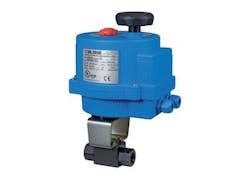6 Things to Consider for Valve Applications in High-Pressure Environments
Gilbert Welsford Jr is the founder of ValveMan.com and a third-generation valve entrepreneur. He has learned valves since a young age and has brought his entrepreneurial ingenuity to the family business in 2011 by creating the online valve store, ValveMan.com. Welsford focus is building on the legacy his grandfather started, his father grew, and he has amplified. Welsford can be reached at [email protected].
undefinedThe selection criteria for a suitable valve is a significant task when designing a fluid control system. The task becomes more rigorous when the operating environment is high-pressure. Parameters such as valve material, leakage of hazardous fluid, etc., must be considered when choosing a high-pressure process operation valve. The safe operation of the valve to personnel and the environment becomes more critical. These parameters are in addition to a valve’s general characteristics that make it suitable for a specific application.
What is a High-Pressure Valve?
Before we can discuss the essential things you should look out for when designing a system that includes high-pressure valves, we must try to clarify what constitutes a “high-pressure valve”. There is no standard definition of a typical Bar or psi threshold that marks the beginning of a high-pressure valve, differentiating it from a medium-pressure valve or a low-pressure valve. Engineers loosely use the term “high-pressure” to mean a valve that can operate at conditions above what would be considered “normal” in their industry.
Although the definition of what is considered high-pressure is inconsistent across industries, the selection principle remains the same. For example, when selecting high-pressure valves for domestic applications at 6 bar or oil and gas processes at 6,000 bar, safety is equally important as both environments are not designed to operate at such high pressure during normal conditions.
From the perspective of a design engineer, high-pressure valves are therefore relative to the environment’s normal operating pressure. This allows us to categorically define the five most important things to look out for when selecting a high-pressure valve for an application.
6 Valve Pressure Considerations
It goes without saying that safety is the most important criteria. However, safety is not a parameter that can be chosen but rather an outcome of other parameters when correctly done. Consequently, we will describe the five parameters essential to guarantee a safe and functional operation of a high-pressure valve.
1. Maximum Operating Pressure
The maximum operating pressure is a valve specification that defines the pressure limit beyond which proper or safe operation of the valve cannot be guaranteed by the manufacturer. All valves, including high-pressure valves, have a maximum operating pressure. The selection of a high-pressure valve is not based on just the high operating pressure of your process stream but also on the potential high-pressure limit when a pump is set at maximum head against a closed valve downstream. The worst-case operational scenario is your selection criteria for high-pressure valves.
2. Operating Temperature
It is common to have the maximum operating temperature alongside the pressure specification for high-pressure valves. Both parameters are often associated with many industrial applications. Look out for a high-pressure valve that also has a temperature limit that meets your process operating temperature.
3. Valve Material
The material for high-pressure valves and the parts determine its resistance to pressure, temperature, wear, corrosion etc. Material incompatibility between the fluid, additives and the valve must also be considered. Industrial valve manufacturers publish incompatibility charts for a detailed list of which fluids can work with a specific valve material.
The valve body and seat can be made of ductile iron; it is cheap and can absorb shock but is not very resistant to corrosion. Brass/bronze are for better corrosion resistance but are usually not high pressure. Though more expensive than iron, brass, or bronze, 316 stainless steel offers corrosion resistance, high tensile strength at high temperature. Valve bodies can also be made of monel (an alloy of nickel and copper) or Inconel (an alloy of nickel, chromium and iron) for better corrosion resistance and corrosive fluid handling while maintaining strength at high temperature.
Other parts of the valve, such as gaskets, seals and packing, are many times made of polytetrafluoroethylene (PTFE) for low friction between moving parts at high pressure and temperature. They may also be made of polyurethane, viton or polyetheretherketone for durability, chemical resistance and corrosion resistance. When choosing the proper valve body material and seat material, it is best to consult a valve expert, especially when the process is deemed high pressure for its application.
4. Connection End Type
The type of end connection used in high-pressure applications is vital to prevent leaks. Threaded end connections are useful when the pipe diameter is small (below 2 inches). Beyond this size, it will be difficult to seal the space between the threads under high pressure. Threaded connections are useful if the valve is to be periodically maintained.
Welded connections are a more popular connection type for high-pressure applications as they guarantee zero leakages. They are also used in hazardous fluid systems. Welded end connections are permanent. There are two types of welded end connections for high-pressure valves: socket welded connections and butt-welded connections.
High-pressure valves can also be connected to pipes using flanged connections, particularly if the valve is larger than 4 inches. Flanged connections are standard in industrial applications, especially high pressure ones. They provide a good enough seal, allow easy maintenance of the valve, and are easy to install. There are multiple flanged connection types and styles under standards DIN 1092-1, ANSI/ASME B16.5 and SAE J518.
5. Leakage Tolerance
Depending on your application, there may be some leakage tolerance, especially if the process fluid is not hazardous. Determine how much leakage can be tolerated from a high-pressure valve to save unnecessary costs associated with zero tolerance valves. Valve leakage is mainly related to the end connection type, but some valves also leak through the packing seal that holds the shaft to the valve’s body.
The amount of leakage tolerance is pressure dependent. High-pressure valve manufacturers provide such information in charts supplied with the valve. MSS standard SP-61 and ANSI standard 70-2 define allowable leakages and leakage classifications for high-pressure valves.
6. Size Availability
High-pressure processes are often operated with smaller pipe diameters. This is because of the material cost of the pipes to hold the pressure without breaking. Though not so obvious, most high-pressure valves in the industry are small. When designing your process, check that there are readily available high-pressure valves for the piping dimensions.
Types of high-pressure valves
Specific types of valves are more suited for high-pressure operations than others. Two characteristics define the types of valves for high pressure.
- High-pressure valves will be required to operate at a high-pressure difference between the valves’ sides if a pressure balancing system is not installed.
- High-pressure valves should not leak through the valve closing at the high-pressure difference
Considering these characteristics, high-pressure valves are often of the following 5 types:
- Globe valve
- Plug valve
- Needle valve
- Ball valve
- Gate valve
These valve types are used in various ways and for different functions in a high-pressure environment, such as flow control (both modulating and on/off), safety, over-pressure, check valves, isolation, flow throttling, special purposes etc. For a high-pressure environment, these valves are slightly modified. Modifications can include non-rotating stems, packing and sealing materials with little contact with the process fluid, positive shutoff mechanism etc.
High-pressure valve applications
High-pressure valves are used in various applications and industries. Some of these industries are oil and gas exploration, petroleum refining and distribution, chemical and petrochemical processing, water supply, wastewater management, food and dairy, aerospace, subsea operations, military, waterjet cleaning and cutting etc.
Flow Control System Considerations
Designing a flow control system for a high-pressure environment requires specific considerations. The most important things to look out for are maximum operating pressure, valve material, connection end type, leakage tolerance and size availability.
This will guarantee a safe and functional working valve at high pressure. Remember that certain types of valves are more suited to the high-pressure operation than others due to their design. Read the manufacturers recommendations and specifications for deciding which high-pressure valve is best for you.


